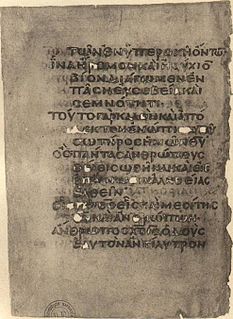
Codex Mutinensis designated by Ha or 014, α 6, is a Greek uncial manuscript of the Acts of Apostles, dated paleographically to the 9th century. The codex contains 43 parchment leaves.

Codex Coislinianus designated by Hp or 015, α 1022 (Soden), was named also as Codex Euthalianus. It is a Greek uncial manuscript of the Pauline epistles, dated palaeographically to the 6th century. The text is written stichometrically. It has marginalia. The codex is known for its subscription at the end of the Epistle to Titus.

Codex Angelicus designated by Lap or 020, α 5, is a Greek uncial manuscript of the New Testament. Palaeographically it has been assigned to the 9th century. Formerly it was known as Codex Passionei.

Codex Campianus is designated as "M" or "021" in the Gregory-Aland cataloging system and as "ε 72" in the Von Soden system. It is a Greek uncial manuscript of the New Testament, dated palaeographically to the 9th century. The manuscript has complex contents. It has marginalia and was prepared for liturgical (religious) use.

Codex Porphyrianus designated by Papr or 025, α 3, is a Greek uncial manuscript of the Acts of Apostles, Pauline epistles, and General epistles, with some lacunae, dated paleographically to the 9th century. It is one of a few uncial manuscripts that include the Book of Revelation.
Uncial 049, α 2. It is a Greek uncial manuscript of the New Testament. Paleographically it has been assigned to the 9th century.

Codex Tischendorfianus II – designated by Uncial 081 α 1023 (Soden), – is a Greek uncial manuscript of the New Testament, dated paleographically to the 6th century.
Uncial 0121b, it was named as Fragmentum Uffenbachianum, or Codex Ruber. It is a Greek uncial manuscript of the New Testament, dated palaeographically to the 10th-century. The manuscript is very lacunose.
Minuscule 81, or α162 is a Greek minuscule manuscript of the New Testament, on a parchment. It is dated by a colophon to the year 1044. Formerly it was labelled by 61a and 61p (Gregory). The manuscript is lacunose. It was adapted for liturgical use.

Uncial 0142 (in the Gregory-Aland numbering), O6 (Soden), is a Greek uncial manuscript of the New Testament, dated paleographically to the 10th century. Formerly it was classified as a minuscule manuscript of New Testament under numbers 46a 55p (Scrivener).
Minuscule 94 (in the Gregory-Aland numbering), O31 (von Soden), is a Greek minuscule manuscript of the New Testament, on parchment and paper, dated to the 12th or 13th century. Formerly it was labelled by 18a, 21p, and 19r.

Minuscule 104, α 103 (Soden), is a Greek minuscule manuscript of the New Testament, on parchment leaves. Palaeographically it has been assigned to the 11th century.
Lectionary 13, designated by siglum ℓ13. It is a Greek manuscript of the New Testament, on vellum leaves. Palaeographically it has been assigned to the 12th-century. Formerly it was known as Colbertinus 1241 or Regius 1982.
Minuscule 250, O 10 (Soden), is a Greek minuscule manuscript of the New Testament, on parchment. Paleographically it has been assigned to the 11th century.
Minuscule 451, α 178, is a Greek minuscule manuscript of the New Testament, on parchment. Palaeographically it has been assigned to the 11th century. Formerly it was labelled by 79a and 90p. The manuscript has not survived in complete condition.
Lectionary 171, designated by siglum ℓ171 is a Greek manuscript of the New Testament, on parchment leaves. Paleographically it has been assigned to the 9th century. Formerly it was labelled as Lectionary 70a. Scrivener by 72a.
Lectionary 178, designated by siglum ℓ178 is a Greek manuscript of the New Testament, on parchment leaves. Paleographically it had been assigned to the 9th century. Formerly it was labelled as Lectionary 71a (Scrivener), 80a (Gregory).
Minuscule 619, α 57, is a Greek minuscule manuscript of the New Testament, on parchment. It is dated by a colophon to the 984. The manuscript has complex contents. Tischendorf labelled it by 148a and 184p.
Minuscule 623, α 173, is a Greek diglot minuscule manuscript of the New Testament, on parchment. It is dated by a colophon to the year 1037. The manuscript is lacunose. Tischendorf labeled it by 156a and 190p.
Codex Tischendorfianus V or Lectionary 293 (Gregory-Aland), designated by siglum ℓ293 is a Greek manuscript of the New Testament, on parchment. Palaeographically it has been assigned to the 8th century. Scrivener labelled it as 190e.














